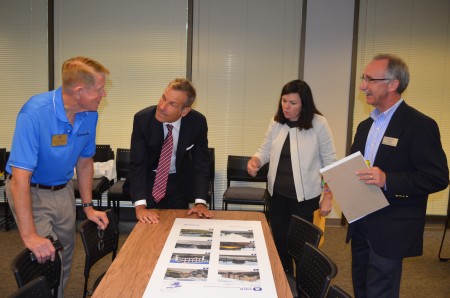
Tony Torbert says he lived for 13 years in a traditional suburban neighborhood in Dunwoody. For the past eight years, he’s lived in a high-rise condo in the Perimeter area of the city.
He doesn’t want the Perimeter to change. He likes the urban feel of the place.
“I love the Perimeter area,” Torbert said. “I can walk to pretty much anywhere. I can take to MARTA to work. To me, what I’d like to see is a lot of design concepts … to take these winding streets, and … to make it more like a city.”
So on Sept. 4, Torbert joined about a dozen Dunwoody officials, planners and other residents who kicked off an effort to develop separate zoning regulations for the portion of the city around Perimeter Mall and the MARTA station.
The effort grew from Dunwoody’s recent rewrite of its city zoning and building codes. After 22 months of debate by residents, consultants and city officials, Dunwoody City Council adopted the new codes last October. City officials said the newly crafted zoning and building codes were intended to create regulations that reflected Dunwoody residents’ tastes and needs.
The Perimeter area intentionally was left out of that zoning rewrite because it is so different from other parts of Dunwoody, city officials said. The Perimeter is an area of high rise offices and residences, shopping centers, restaurants and hotels. It needs its own building and zoning rules, city officials and consultants say.
“Because it’s so unique, because it’s so important to the city, it needs to be [dealt with] by itself,” said consultant Kirk Bishop of Duncan Associates of Chicago, who helped draft the city’s new zoning and building codes, and is working on the Perimeter area zoning project. “We need new Perimeter Center guidelines that address what the area truly is and what it could become.”
Bishop said the consultants hope to develop general recommendations on how best to proceed over the next several months and then deliver a draft of the plan to the council in about a year.
Although portions of the Perimeter area lie in Sandy Springs and Brookhaven, Dunwoody officials and planners say the zoning proposal they are developing will apply only in Dunwoody. They will share the proposal with officials from the other two cities, they say, who may then want to consider their own ordinances.
Dunwoody officials will look at a variety of questions, including what sorts of development fit in the area, where new buildings might go and how the city could best regulate them, Bishop said. Some future developments may rise in areas that now are parking lots, he said.
He said the consultants also were aware that new projects in the Perimeter area also could affect surrounding neighborhoods. Initial plans for the project divide the Perimeter into three zones: the core, the general area and the edges.
Torbert said one reason he likes living in the Perimeter area is that he can walk to many places he needs to go. It’s a short stroll to the MARTA station, he said, and he can take a train to work at his job in Atlanta. “I’ll go three or four days and not get in my car,” he said.
Still, he’d like to see his neighborhood grow even more urban. “I wish we were more walkable,” he said.
